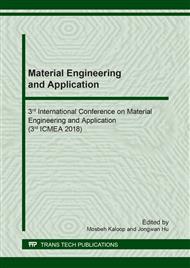p.120
p.126
p.131
p.137
p.144
p.150
p.155
p.161
p.170
A Study on the Compressive Strength Properties and Quality Control of Lightweight Foamed Magnesia Composite Using Super Absorbent Polymers as Base Material for Biological Panels
Abstract:
In this paper, the compressive strength quality characteristics of lightweight formedmagnesia composite using super absorbent polymer as basic material for biological panels wereevaluated. The experimental parameters were evaluated with respect to the compressive strength ofthe mortar according to the water binder ratio (W/B), the volume ratio of fine aggregate (Vs/Vm), theamount of foaming agent (FA) and the amount of super absorbent polymer (SAP). Statistical analysiswas performed on the compressive strength obtained through the experiment and the influencecoefficient on the compressive strength quality was obtained. The compressive strength qualityprediction model equation of the magnesia composite is proposed through the obtained influencecoefficient. The proposed model equation shows that the experimental and predicted values are over80%.
Info:
Periodical:
Pages:
144-149
Citation:
Online since:
November 2018
Authors:
Keywords:
Price:
Сopyright:
© 2018 Trans Tech Publications Ltd. All Rights Reserved
Share:
Citation:


